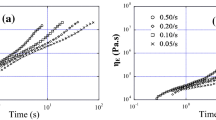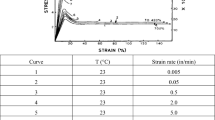Abstract
High-impact polystyrene [HIPS], a two-phase polymeric system, has been investigated studying the pressure dependence of stress-elongation behaviour in tension over the range from atmospheric pressure to 4 kbar at room temperature and constant strain-rate. A comparative study of polystyrene [PS] was also undertaken. HIPS sealed from the environment exhibited ductile behaviour at all pressures. Surprisingly, specimens exposed to silicone oil environment exhibited two transitions as the applied hydrostatic pressure was raised: a ductile-to-brittle followed by a brittle-to-ductile transition. Stress-whitening was suppressed at relatively low pressures. The dilational requirement for profuse crazing was restrained by the combined effect of fluid under pressure resulting in the suppression of the energy absorption mechanism.
Analysis of the stress-elongation curves for sealed specimens indicated that the pressure dependency of craze-initiation stress differs from that of shear band initiation stress. The brittle-to-ductile transition occurred when the initiation stresses of both processes became equal. The principal stress for craze initiation showed almost no pressure dependency, suggesting that crazes initiate when the principal stress level of the tensile specimen reaches a critical value irrespective of the applied hydrostatic pressure. A value for the proposed triaxial tension around the rubber particles was determined from the experimental results and found to be in good agreement with a calculated value. A general mechanics argument was used to explain the existence of the ductile-to-brittle and the brittle-to-ductile transition in HIPS, and also to predict the pressure dependencies of brittle-fracture stress and craze-initiation stress for sealed and non-sealed specimens.
Similar content being viewed by others
Abbreviations
- P :
-
hydrostatic pressure, here taken as always positive
- BD:
-
brittle-to-ductile transition
- CS:
-
craze-to-shear band transition
- σ T :
-
observed tensile stress
- σ 1 :
-
the first principal stress
- σ sf :
-
fracture stress for sealed specimens
- σ nsf :
-
fracture stress for non-sealed specimens
- σ y :
-
yield stress
- σ f :
-
fracture stress
- σ ci :
-
craze initiation stress
References
J. L. Amos, J. L. McCardy and O. R. McIntire (to The Dow Chemical Company) US Pat. 2, 694, 692, (November 16, 1954).
G. E. Molau and H. Keskkula, J. Polymer Sci. A-1 4 (1966) 1595.
H. Keskkula, Appl. Polymer Symp. 15 (1970) 51.
E. H. Merz, G. C. Claver and M. Baer, J. Polymer Sci. 22 (1956) 325.
H. Willersinn, Makromol. Chem. 101 (1966) 297.
C. B. Bucknall and R. R. Smith, Polymer 6 (1965) 437.
R. Kambour, Appl. Polymer Symp. 7 (1968) 215.
S. L. Rosen, Polymer Eng. Sci. 7 (1967) 115.
J. A. Schmitt, J. Appl. Polymer Sci. 12 (1968) 533.
G. Biglione, E. Baer and S. V. Radcliffe, Proceeding of the Second International Conference, Brighton, 1969, edited by P. L. Pratt (Chapman and Hall, London, 1969).
K. Matsushige, S. V. Radcliffe and E. Baer, J. Mater. Sci. 10 (1975) 833.
G. Das and S. V. Radcliffe, J. Jap. Inst. Metals 9 (1968) 334.
K. Matsushige, E. Baer and S. V. Radcliffe, J. Macromol. Sci. Phys. Bll 4 (1975) 565.
L. E. Nielsen, “Mechanical Properties of Polymers” (Reinhold, New York, 1962) pp. 131–33.
A. A. Griffith, Phil. Trans. Roy. Soc. London Ser. A 221 (1921) 163.
H. H. Stuart, G. Mankowski and D. Jeschke, Kunststoffe 54 (1964) 618.
G. A. Bernier and R. P. Kambour, Macromolecules 1 (1968) 393.
E. H. Andrews and L. Bevan, Polymer 13 (1972) 337.
H. Pugh, G. Hodgson and D. A. Gunn, J. Sci. Instrum. 40 (1963) 221.
Author information
Authors and Affiliations
Rights and permissions
About this article
Cite this article
Trent, J.S., Miles, M.J. & Baer, E. The mechanical behaviour of high-impact polystyrene under pressure. J Mater Sci 14, 789–799 (1979). https://doi.org/10.1007/BF00550709
Received:
Accepted:
Issue Date:
DOI: https://doi.org/10.1007/BF00550709




